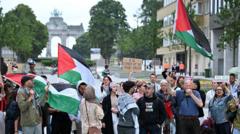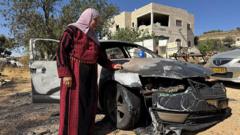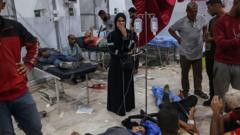A month after the launch of a US- and Israeli-supported aid distribution framework in Gaza, reports outline frequent incidents of gunfire and chaos. Over 500 individuals reportedly lost their lives while attempting to access aid, according to the Hamas-run health ministry, leading to intensified scrutiny and condemnation from international bodies.
Chaos Continues in Gaza Amid New Aid Distribution Efforts

Chaos Continues in Gaza Amid New Aid Distribution Efforts
A BBC analysis reveals a month of turmoil and violence surrounding the newly implemented aid distribution system in Gaza, which has resulted in significant casualties among civilians seeking assistance.
In the wake of a controversial aid distribution system launched in Gaza, recent reports indicate a troubling surge in violence. Analysis from BBC Verify highlights the chaos surrounding food aid collection, which has resulted in over 500 reported deaths and 4,000 injuries among civilians, most attributed to Israeli gunfire, according to the Hamas health ministry. Eyewitness accounts confirm an environment permeated with gunfire and panic, casting doubt on the safety surrounding these new humanitarian initiatives.
The Israel Defense Forces (IDF) maintain that they have only fired warning shots at individuals deemed suspicious. However, the situation remains fraught with tension, with many aid-seekers reportedly caught in crossfire as they navigate dangerous routes. The UN has expressed concern that the militarization of aid distribution undermines existing relief efforts and endangers lives.
Since the easing of Israel's blockade on aid in mid-May, distribution sites have been established but are operated under tight security measures. Despite claims from the Gaza Humanitarian Foundation (GHF) that they are facilitating safe routes for aid, numerous incidents of violence have continued, including reported mass casualties among groups attempting to receive assistance.
One notable incident involved the reported killing of multiple individuals near an aid distribution truck, suggesting a pattern of dangerous encounters surrounding these sites. Amid ongoing chaos, human rights activists underscore the severity of the crisis, asserting that targeting civilians seeking aid lends itself to accusations of potential war crimes.
In light of the increasing casualties, the GHF has called for greater quantities of aid to alleviate the urgency that leads many to risk their lives in search of assistance. While the intended infrastructure aims to improve food access for Gazans, the reality on the ground remains starkly different, marked by violence and trepidation.
Reports continue to emerge as the situation unfolds, with humanitarian organizations striving for safer aid deliveries and a resolution to the escalating conflict and confusion in Gaza.
The Israel Defense Forces (IDF) maintain that they have only fired warning shots at individuals deemed suspicious. However, the situation remains fraught with tension, with many aid-seekers reportedly caught in crossfire as they navigate dangerous routes. The UN has expressed concern that the militarization of aid distribution undermines existing relief efforts and endangers lives.
Since the easing of Israel's blockade on aid in mid-May, distribution sites have been established but are operated under tight security measures. Despite claims from the Gaza Humanitarian Foundation (GHF) that they are facilitating safe routes for aid, numerous incidents of violence have continued, including reported mass casualties among groups attempting to receive assistance.
One notable incident involved the reported killing of multiple individuals near an aid distribution truck, suggesting a pattern of dangerous encounters surrounding these sites. Amid ongoing chaos, human rights activists underscore the severity of the crisis, asserting that targeting civilians seeking aid lends itself to accusations of potential war crimes.
In light of the increasing casualties, the GHF has called for greater quantities of aid to alleviate the urgency that leads many to risk their lives in search of assistance. While the intended infrastructure aims to improve food access for Gazans, the reality on the ground remains starkly different, marked by violence and trepidation.
Reports continue to emerge as the situation unfolds, with humanitarian organizations striving for safer aid deliveries and a resolution to the escalating conflict and confusion in Gaza.





















